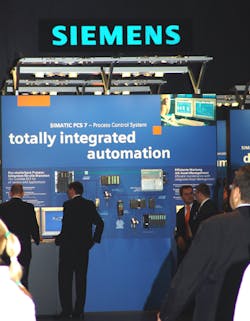Hanover Fair Showcases "Energy Mix of the Future"
Hannover Messe 2009 (or Hanover Fair, as it’s commonly referred to in the U.S.) was held April 20-24 in Hannover, Germany, serving as the world’s largest gathering of industry professionals, exhibitors, industry organizations and nations. “Leading personalities from science and industry come together in Hannover in order to present technologies,” said Dr. Willi Fuchs, Director of the Association of German Engineers (VDI).Dr. Reinhard Hüppe, Managing Director of the German Electrical and Electronic Manufacturers’ Association (ZVEI), stressed, “HANNOVER MESSE is the most important event of the year for the electrical engineering industry—not least for the electric automation and energy sectors. Only in the context of free competition can these sectors demonstrate their true strengths.”Siemens takes a leadership roleHighlighting the Fair’s main themes, the focus for Siemens AG at Hanover Fair was on cost-effective innovations and energy-efficient solutions. Siemens views the current economic environment as a good opportunity to increase its market share in industrial equipment and solutions.Speaking at a press conference held prior to Hanover Fair, Klaus Helmrich, CEO of the Drive Technologies Division, stated, “It is especially in times of changing economic conditions that industrial companies expect systematic solutions that help cut costs while also securing their investment. As leading industry suppliers we are deliberately targeting energy-efficient and cost-effective innovations, which permit our customers to achieve an early return on investment.”Against the backdrop of declining greenfield business, it is efficiency, flexibility and reliability of existing plants that have gained in importance in the global marketplace. “Here, economical operations go hand-in-hand with environmental protection using green solutions,” stated Jens Wegmann, CEO of Siemens Industry Solutions. “In a large number of modernization projects, they help us save more than three quarters of the cost of energy.”Roughly 50 percent of the overall power consumption in developed countries is used in industry, over two thirds of which is consumed by electric drive systems. “We estimate that the use of variable-speed drives and highly efficient motors could generate global savings of 120 terra-watt hours,” Helmrich continued. “Payback for the majority of our new drive systems is less than 18 months.”Besides drives, control systems also contribute towards energy efficiency by ensuring that power is only used where it is actually needed. “While individual energy-efficient products can make a considerable contribution to reducing energy consumption, only a smart combination of these systems from planning through to operation within the framework of Siemens’ Totally Integrated Automation can effectively leverage this potential,” stated Ralf-Michael Franke, CEO of Industrial Automation Systems. “We are driving forward our world leading automation portfolio with innovations designed to increase productivity and cut costs for our customers.” For example, said Franke, “The new Simatic S7-1200 Micro-Controller is setting whole new standards and opening up new dimensions in terms of performance and efficiency for our customers.”13 shows in oneHanover Fair 2009 encompassed 13 leading trade fairs, including:• INTERKAMA• Factory Automation• Industrial Building Automation• MDA (Motion, Drive & Automation)• Digital Factory• Subcontracting• Energy• Wind• Power Plant Technology• ComVac• Surface Technology• MicroTechnology• Research & TechnologyOne of the featured topics at the Fair was “Energy Efficiency in Industrial Processes,” with a special display for innovative and energy-efficient products, solutions and processes. A model of a bioethanol plant (5 x 2.5 meters) illustrated ways of optimizing consumption, while a presentation area dedicated to reference projects focused on examples of best practice in optimizing energy efficiency in industrial processes.The fourth annual World Energy Dialogue took place at Hanover Fair on April 21 and 22. Chaired by Dr. Klaus Töpfer, former Executive Director of the United Nations Environment Programme (UNEP), the dialogue featured contributions by federal ministers and well-recognized energy experts and policymakers from Europe, Africa, Asia and the U.S.While these activities highlight the importance of energy savings, there are also growing pressures on industrial companies to save costs by increasing productivity over the manufacturing and product life cycle. At Hanover Fair, Siemens showcased its portfolio of Totally Integrated Automation (TIA) and digital engineering solutions designed to improve efficiencies and lower operating costs. “In addition to consistent, end-to-end IT systems for asset management, human-machine interfaces (HMI) and manufacturing execution systems (MES), we at Siemens are focusing on developments in digital engineering to make production advantages available to our customers," explained Franke.Siemens is poised to serve industry across all three sectors of the environmental portfolio—energy efficiency, water management and pollution control. And, with TIA and digital engineering solutions, Siemens provides its customers with competent and specific support for cost-saving innovations.

